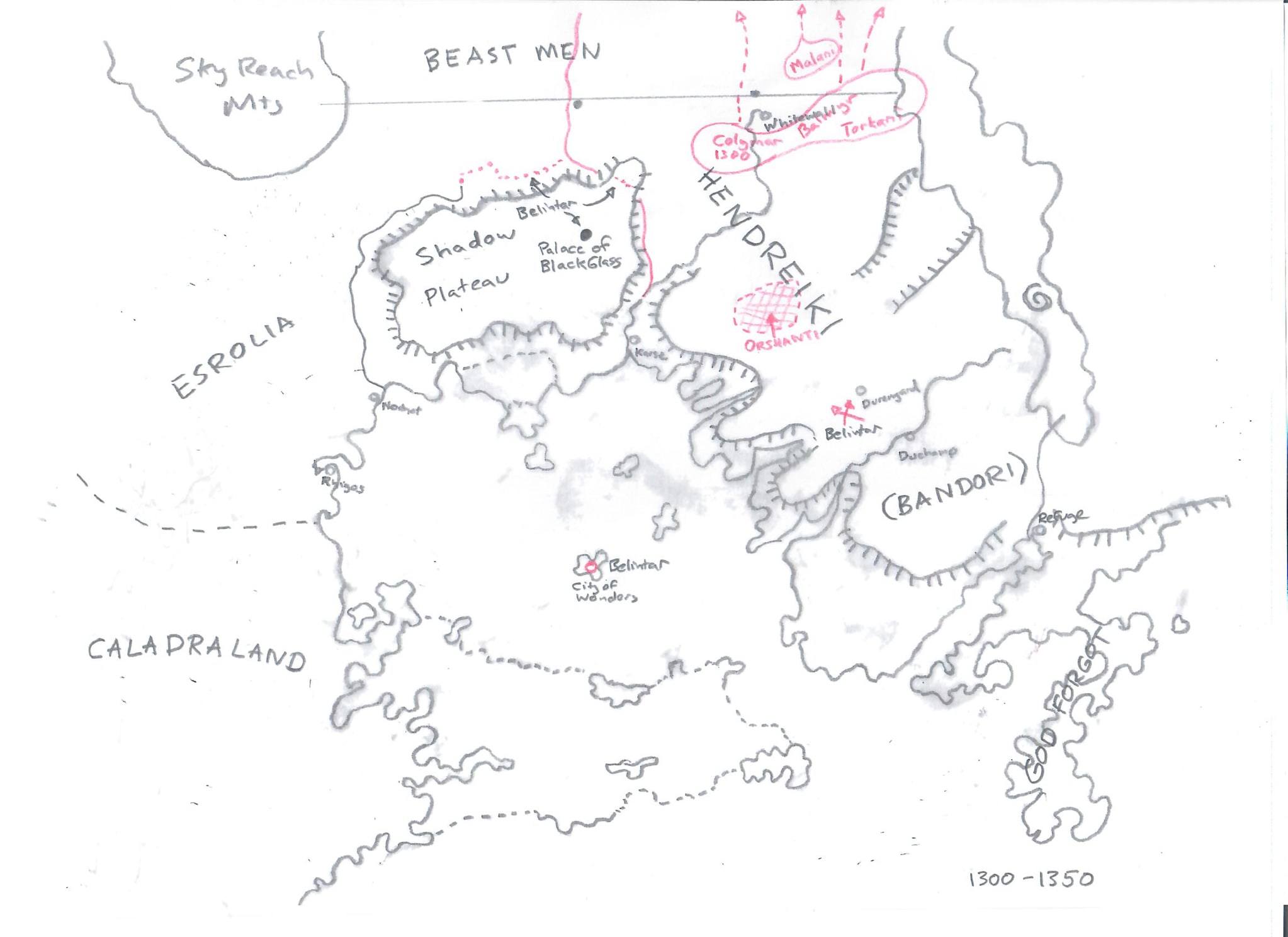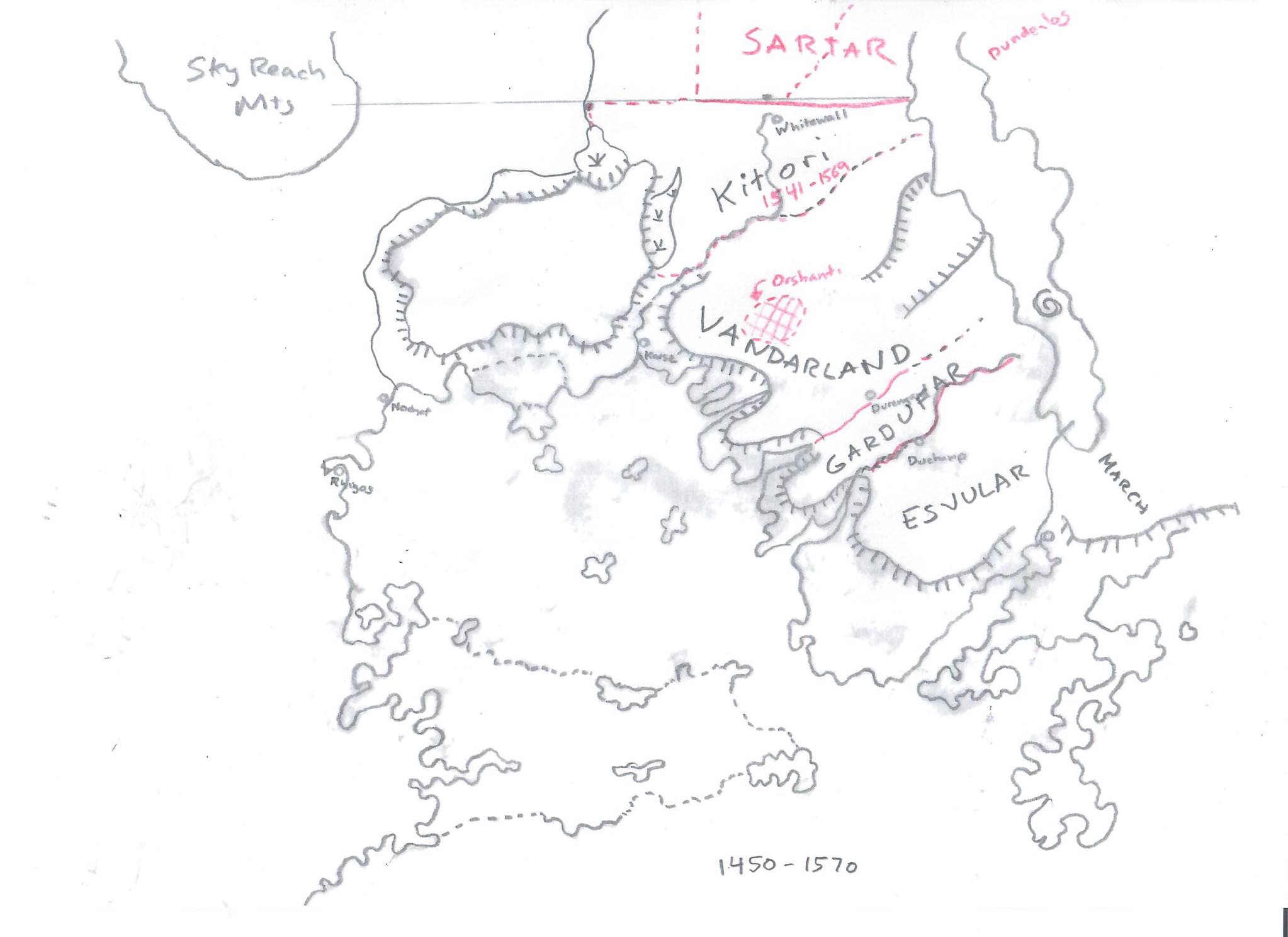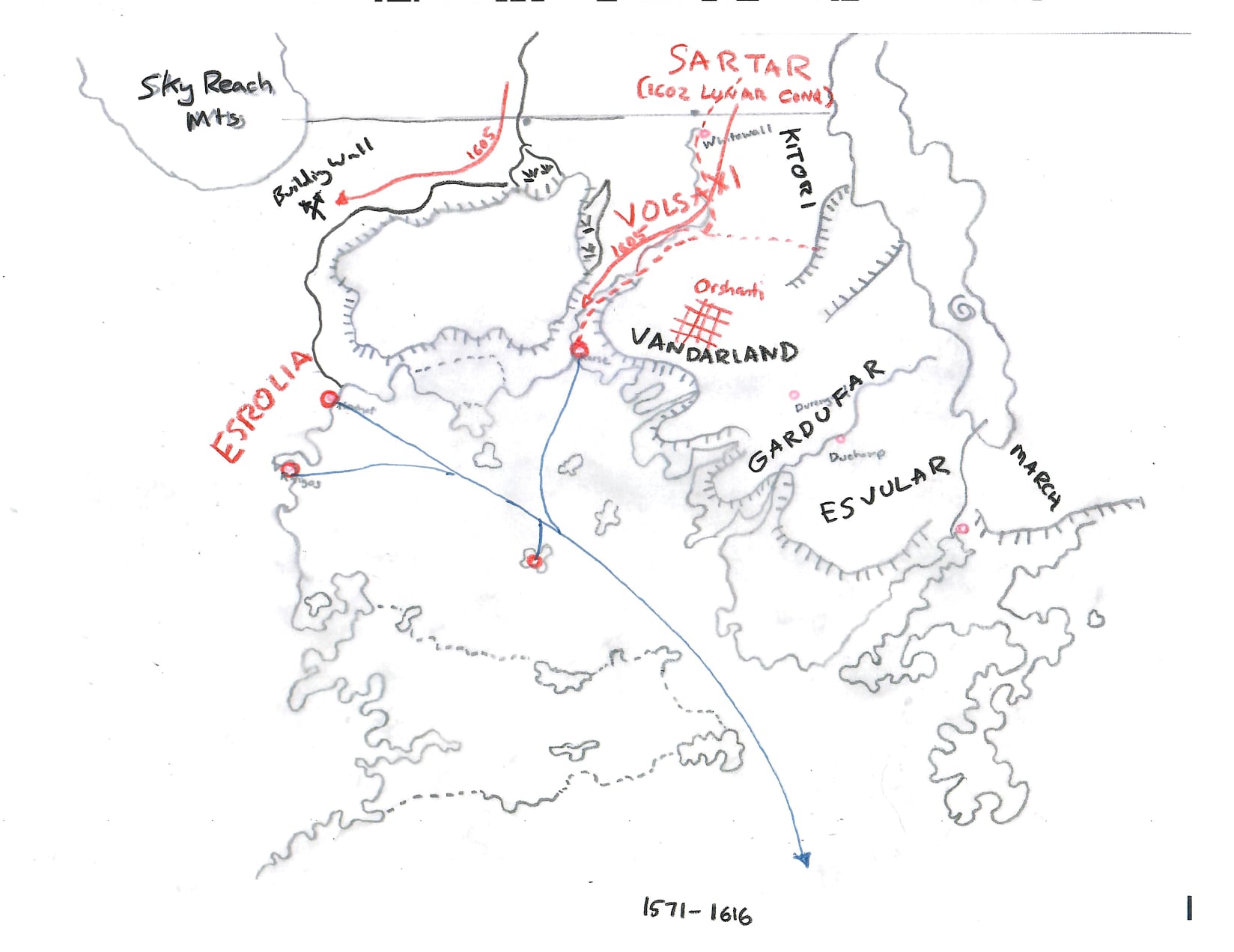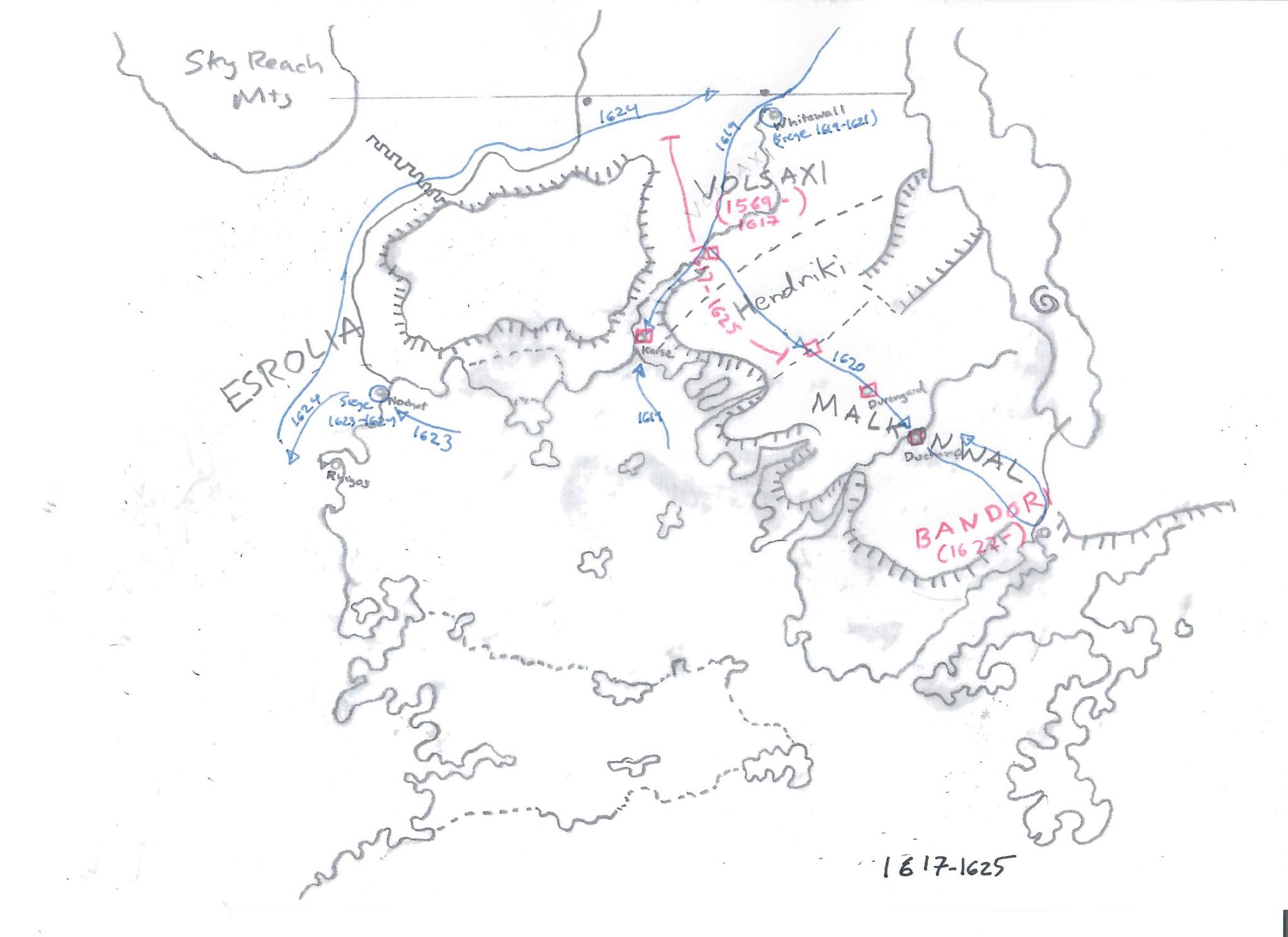By 1350, the Hendriki kingdom is gone. Heortland – named after the great cultural hero who was often invoked by Belintar – was a Sixth of the Holy Country. The God-King kept good contacts with all the gods of the Holy Country, and to the rest of the world this was a part of the Otherworld manifest in the mundane world. Occasionally, gods or great monsters visited the Holy Country, and there were known to be many secret gates into the Otherworld. The Orlanth cult was strongly supported, but one that worked in conjunction with the other gods of the Sixths – a Monomythed Orlanth that could play A leading role (but not THE leading role) in something larger. This was intolerable to the would be heirs of the Hendriki and in 1340, a group of clans gathered at Whitewall and acclaimed Hardard the Green as king of the Volsaxi confederation. The Volsaxi proclaimed their independence and autonomy. Curiously Belintar took no direct action against the Volsaxi, although his governors in Heortland often fought against them. During this rebellion, other groups entered Dragon Pass – the Locaem, Kultain, and Dundealos tribes among others.
When Belintar came to the Holy Country, trolls and Hendriki tribe were dominant. The Hendriki were not an Orlanth Rex tribe, like the tribes in Sartar, and did not have access to that magic.Initially they were a “clan” – Hendrik was a bandit leader, not a king. His warband was held together by his own charisma and magic. When Hendrik died in 439, one of his companions Selelmal took over leadership of Hendrik’s band, aka the Hendriki.
It was Dinorth who actually founded the kingdom. He was given the magical regalia by Sindan Black who journeyed to the Western Ocean and returned. These were a crown, a scepter, and six magical items. Possession of this regalia and the tribal rites made one king. Clans obeyed the king or not, but the king was the king. The Hendriki expanded and contracted over the centuries. Sometimes they were little more than just the area around Whitewall. Sometimes they ruled all of Heortland and much of Esrolia.
In 1300, the Hendriki ruled most of Heortland. The Bandori were a subject tribe. Southern Heortland was ruled by the Bandori, a subject tribe of the Hendriki. The Orshanti were a large clan centered on what is now Jansholm. They split over the rise of the Red Moon, with Colymxar and his Esrolian wife leading his Black Spear Clan – zealots, visionaries, and adventurers – into Dragon Pass.
In 1313, Belintar arrived. We all know the story. He killed the Hendriki King, who supported the Only Old One, and then a year later resurrected him. Many Hendriki refused to acknowledge the returned king, others did, and others directly revered Belintar. Some groups decided to risk exile into Dragon Pass.
Heortland was mostly administered according to traditional law, but social institutions did change. Clans tended to have a single ruling family, from which the leader would be chosen, etc. Clans supported heavy chariot cavalry (that were eventually supplanted by heavy horse cavalry once large enough horses could be reliably obtained from the Grazelands.
Heortland itself is divided into four provinces: Vandarland, Gardufar, and Esvular. The fourth, Volsaxiland, largely governs itself. The borders change from time to time., but basically they are this:
- Volsaxi – from the Crossline to the Marzeel River.
- Vandarland – from the Marzeel to either the Syphon or the Bullflood rivers.
- Gardufar – from the Syphon or Bullflood rivers to the Minthos.
- Esvular – from the Minthos to the Nomad Marches.
In 1541, the trolls of the Troll Woods took control of Whitewall and broke the Volsaxi confederation. The Kitori took control of trade between Sartar (and Peloria and Prax) and the rest of the Holy Country, and imposed high tariffs (basically robbery). This lasted until Prince Tarkalor defeated the Kitori with the aid of the Yelmalio cult. He refounded the Volsaxi confederation at Whitewall and built a road between Whitewall and Karse. All of this was done with Belintar’s tacit approval. This greatly increased trade between Sartar and the Holy Country, and made the Sartar princes rich enough to contend with the Lunar Empire for another 30+ years.
In 1616, Belintar disappeared. The governor of Heortland died and in 1617, two kingdoms divided Heortland between them. In the north, Broyan of the Volsaxi proclaimed the return of the Hendriki kingdom with himself as king. Much of Vandarland acknowledged him. Gardufar and Esvular supported the Western adventurer Rikard the Tiger-hearted, who proclaimed his kingdom of New Malkonwal. The two successor states lasted only two years before the Lunar Empire invaded in 1619. All of Volsaxiland (except Whitewall) quickly fell. In 1620, Malkonwal fell. Small Lunar garrisons were placed in all the larger cities of Heortland, and in 1621 Whitewall fell.
But even this lasted only a short time. In 1622, Broyan reappeared and raised the Hendriki in rebellion, and many in the former Malkonwal supported him. The Bandori proclaimed their independence as well. Broyan inflicted a surprising defeat on the Lunar Army at Auroch Hills northwest of Whitewall and then fled to Esrolia to aid the new anti-Lunar queen. The Lunars followed in 1623 and besieged Nochet for a year to no avail, while their garrisons in Heortland were withdrawn. In 1624, the Lunar Army was routed at Pennel Ford and had to march all the way back to Sartar. Then in 1625, Broyan was killed and nobody knows how to perform his rites.
So that’s where things are now. A confused mess. No tribes beyond the Bandori. Just a lot of warlords, adventurers, and ad hoc arrangements. I suspect that’s how things will remain until 1628.





